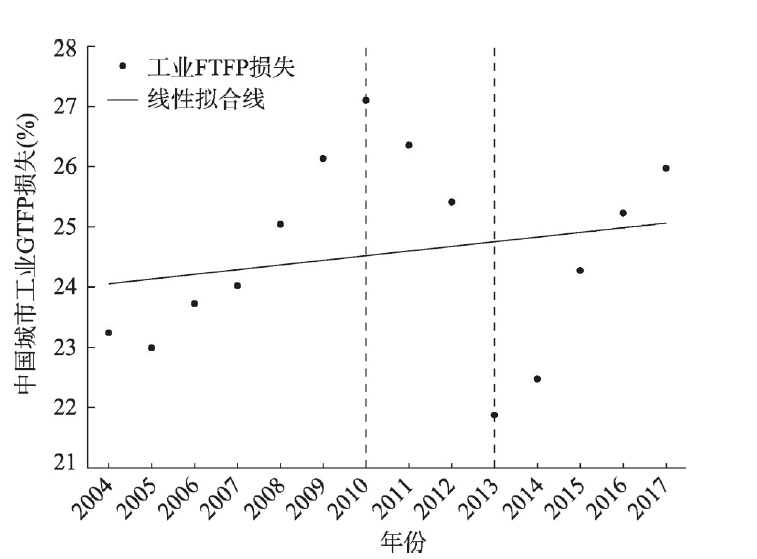

土地资源错配对中国城市工业绿色全要素生产率的影响
|
邓楚雄(1974-), 男, 湖南衡阳人, 教授, 博导, 研究方向为资源评价与区域经济。E-mail: dcxppd@163.com |
收稿日期: 2020-08-28
要求修回日期: 2021-07-08
网络出版日期: 2021-10-25
基金资助
国家自然科学基金项目(U19A2047)
国家自然科学基金项目(71773028)
湖南省教育厅重点项目(18A044)
版权
The impacts of land misallocation on urban industrial green total-factor productivity in China
Received date: 2020-08-28
Request revised date: 2021-07-08
Online published: 2021-10-25
Supported by
National Natural Science Foundation of China(U19A2047)
National Natural Science Foundation of China(71773028)
Research Foundation of Education Bureau of Hunan Province, China(18A044)
Copyright
基于价格扭曲效应拓展资源错配模型,使用中国285个城市2004—2017年的工业投入产出数据,测算土地资源错配导致的城市工业绿色全要素生产率(GTFP)损失,并分析其时空变化。结果表明:① 土地资源错配对中国城市工业GTFP损失的年均贡献率为10.05%,已与能源错配并列成为继资本错配之后城市工业GTFP损失的重要贡献者。② 土地资源错配导致中国城市工业GTFP损失呈现“先小幅下降,再大幅上升,后较大幅度下降”的时序变化特征,但总体趋于上升,损失值介于1.10%~2.48%之间,纠正土地资源错配,中国现有城市的工业GTFP有望实现年均2%左右的再增加;东、中部地区土地资源错配导致的城市工业GTFP损失呈现出与全国层面类似的变化特征,西部地区的城市工业GTFP损失整体保持高位,总体稍有下降,东部地区是中国城市工业发展的主要阵地,其土地资源错配导致的城市工业GTFP损失主导着全国层面的城市工业GTFP损失变化。③ 土地资源错配导致中国城市工业GTFP损失的空间格局呈连片集聚化的发展特征,城市工业GTFP损失较高和高等级省份的数量有所增加,逐渐集中到以黄河流域为主的北方地区,损失低和中等等级省份的数量相应减少,逐渐集中到长江流域及东部沿海地区;土地资源错配导致中国城市工业GTFP损失的总差异呈缩小态势,三大地区内城市工业用地配置效率不均衡是土地资源错配导致中国城市工业GTFP损失差异的根本原因,其中西部地区内城市工业用地配置效率不均衡是主要原因,近年来的区域协同发展有利于三大地区间城市工业用地配置效率差距的缩小。

邓楚雄 , 赵浩 , 谢炳庚 , 李忠武 , 李科 . 土地资源错配对中国城市工业绿色全要素生产率的影响[J]. 地理学报, 2021 , 76(8) : 1865 -1881 . DOI: 10.11821/dlxb202108004
This paper expands the resource misallocation model based on the effect of price distortion. It measures the green total-factor productivity (GTFP) loss of urban industry due to land misallocation and analyzes its spatial and temporal changes by using the industrial input-output data of 285 cities in China from 2004 to 2017. The main results are as follows: (1) Capital misallocation still plays the most important role in the urban industrial GTFP loss, followed by land misallocation (10.5%) and energy misallocation. (2) The characteristics of industrial GTFP loss in Chinese cities induced by land misallocation can be summarized as "initially a small decline, then a large increase, and finally a large decline". Overall, the urban industrial GTFP loss increased, ranging from 1.10% to 2.48%. A correction in land misallocation is expected to bring about a 2% increase of industrial GTFP among Chinese cities. The characteristics of urban industrial GTFP loss due to land misallocation in the eastern and central regions are similar as that at the national level, while the loss in the western region maintains a high value with a slight overall decline. The eastern region is at the forefront of China's urban industrial development, and its industrial GTFP loss due to land misallocation dominates changes at the national level. (3) The spatial pattern of urban industrial GTFP loss in China due to land misallocation is characterized by contiguous clustering. The number of provinces with higher- and high-grade urban industrial GTFP loss has increased, gradually clustering in the northern region, mainly in the Yellow River basin. The number of provinces with low- and medium-grade loss has decreased and are mainly concentrated in the Yangtze River basin and the eastern coastal region. The total variation in urban industrial GTFP loss due to land misallocation among Chinese cities has been narrowed. The unbalanced allocation efficiency of urban industrial land in the three regions is the fundamental cause for the contrasting loss in urban industrial GTFP from land misallocation. In particular, the unbalanced allocation efficiency of urban industrial land in the western region is the main reason. The collaborative regional development in recent years is conducive to bridging the gap in the allocation efficiency of urban industrial land among the three regions.

表1 变量统计性描述Tab. 1 Statistical description of variables |
| 变量 | 均值 | 标准误 | 最小值 | 最大值 |
|---|---|---|---|---|
| 工业总产值(亿元) | 1227.447 | 3067.595 | 0.591 | 35492.740 |
| 资本存量(亿元) | 640.755 | 1168.131 | 0.946 | 13324.490 |
| 劳动力数量(万人) | 11.297 | 21.500 | 0.040 | 260.925 |
| 工业用地面积(km2) | 25.520 | 51.168 | 0.010 | 736.800 |
| 能源消耗量(万t标准煤) | 288.206 | 471.147 | 0.741 | 4219.451 |
| SO2排放量(万t) | 0.966 | 4.213 | 0.000 | 59.333 |
注:因保留三位小数,故部分数据显示为0.000。 |
| [1] |
[ 谢花林, 王伟, 姚冠荣, 等. 中国主要经济区城市工业用地效率的时空差异和收敛性分析. 地理学报, 2015, 70(8):1327-1338.]
|
| [2] |
|
| [3] |
[ 杨海泉, 胡毅, 王秋香. 2001—2012年中国三大城市群土地利用效率评价研究. 地理科学, 2015, 35(9):1095-1100.]
|
| [4] |
|
| [5] |
[ 夏方舟, 李洋宇, 严金明. 产业结构视角下土地财政对经济增长的作用机制: 基于城市动态面板数据的系统GMM分析. 经济地理, 2014, 34(12):85-92.]
|
| [6] |
|
| [7] |
|
| [8] |
[ 吴得文, 毛汉英, 张小雷, 等. 中国城市土地利用效率评价. 地理学报, 2011, 66(8):1111-1121.]
|
| [9] |
[ 何好俊, 彭冲. 城市产业结构与土地利用效率的时空演变及交互影响. 地理研究, 2017, 36(7):1271-1282.]
|
| [10] |
|
| [11] |
|
| [12] |
|
| [13] |
[ 余泳泽, 宋晨晨, 容开建. 土地资源错配与环境污染. 财经问题研究, 2018(9):43-51.]
|
| [14] |
|
| [15] |
|
| [16] |
[ 黄茂兴, 叶琪. 马克思主义绿色发展观与当代中国的绿色发展:兼评环境与发展不相容论. 经济研究, 2017, 52(6):17-30.]
|
| [17] |
|
| [18] |
[ 周亮, 车磊, 周成虎. 中国城市绿色发展效率时空演变特征及影响因素. 地理学报, 2019, 74(10):2027-2044.]
|
| [19] |
[ 陈永伟, 胡伟民. 价格扭曲、要素错配和效率损失: 理论和应用. 经济学(季刊), 2011, 10(4):1401-1422.]
|
| [20] |
|
| [21] |
|
| [22] |
[ 朱喜, 史清华, 盖庆恩. 要素配置扭曲与农业全要素生产率. 经济研究, 2011, 46(5):86-98.]
|
| [23] |
[ 陈诗一, 陈登科. 中国资源配置效率动态演化: 纳入能源要素的新视角. 中国社会科学, 2017(4):67-83,206-207.]
|
| [24] |
|
| [25] |
|
| [26] |
[ 盖庆恩, 朱喜, 程名望, 等. 土地资源配置不当与劳动生产率. 经济研究, 2017, 52(5):117-130.]
|
| [27] |
[ 李力行, 黄佩媛, 马光荣. 土地资源错配与中国工业企业生产率差异. 管理世界, 2016(8):86-96.]
|
| [28] |
[ 张雄, 张安录, 邓超. 土地资源错配及经济效率损失研究. 中国人口·资源与环境, 2017, 27(3):170-176.]
|
| [29] |
[ 杨振兵, 邵帅, 杨莉莉. 中国绿色工业变革的最优路径选择: 基于技术进步要素偏向视角的经验考察. 经济学动态, 2016(1):76-89.]
|
| [30] |
[ 龚关, 胡关亮. 中国制造业资源配置效率与全要素生产率. 经济研究, 2013, 48(4):4-15, 29.]
|
| [31] |
[ 才国伟, 杨豪. 外商直接投资能否改善中国要素市场扭曲. 中国工业经济, 2019(10):42-60.]
|
| [32] |
|
| [33] |
|
| [34] |
|
| [35] |
[ 涂正革. 工业二氧化硫排放的影子价格: 一个新的分析框架. 经济学(季刊), 2010, 9(1):259-282.]
|
| [36] |
[ 吴延瑞. 生产率对中国经济增长的贡献: 新的估计. 经济学(季刊), 2008, 7(3):827-842.]
|
| [37] |
|
| [38] |
[ 李菁, 胡碧霞, 匡兵, 等. 中国城市土地利用效率测度及其动态演进特征. 经济地理, 2017, 37(8):162-167.]
|
| [39] |
[ 夏四友, 赵媛, 许昕, 等. 江苏省粮食生产时空格局及其驱动因素. 经济地理, 2018, 38(12):166-175.]
|
/
| 〈 |
|
〉 |